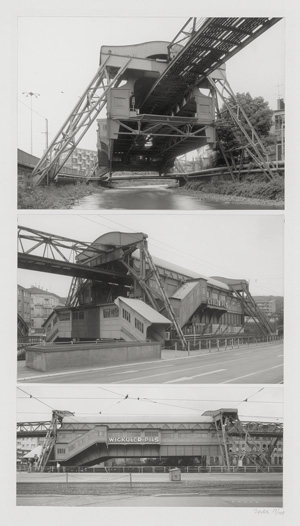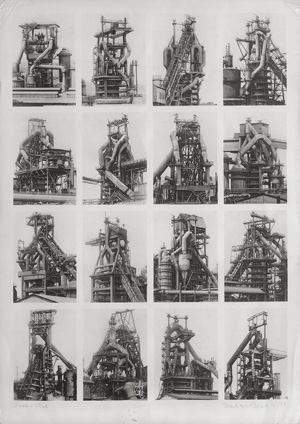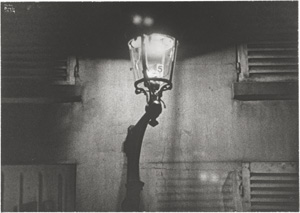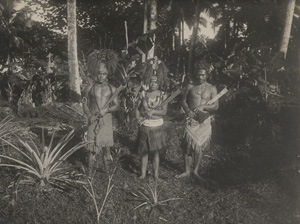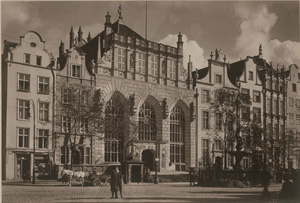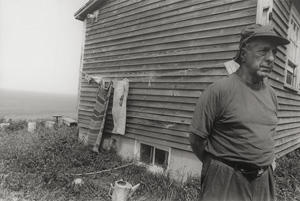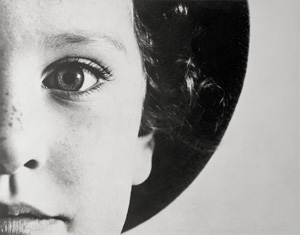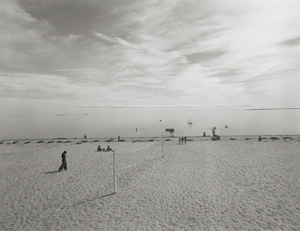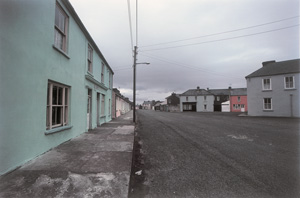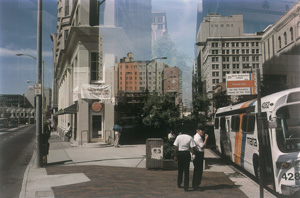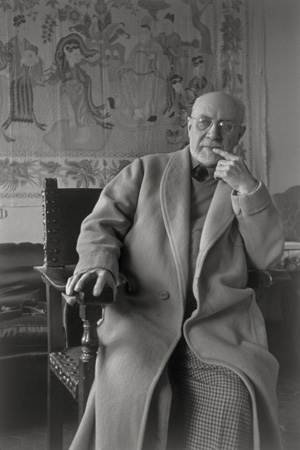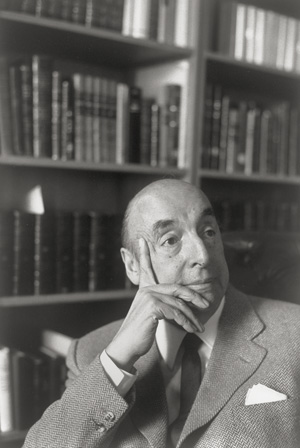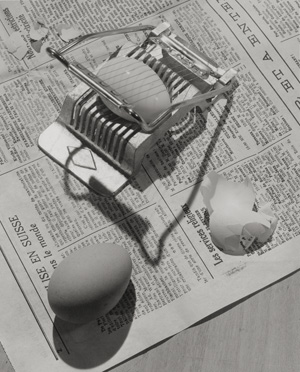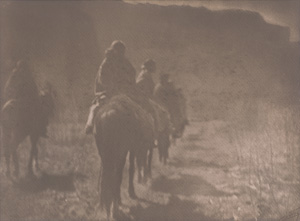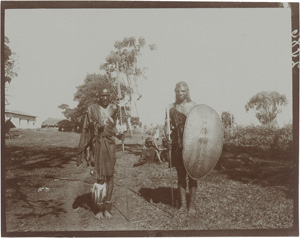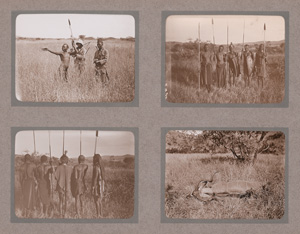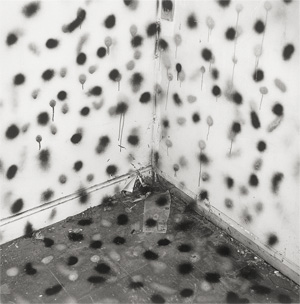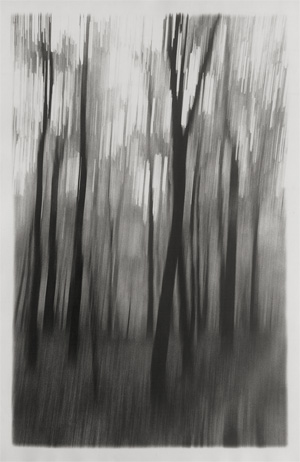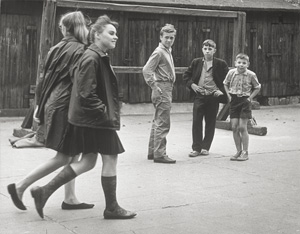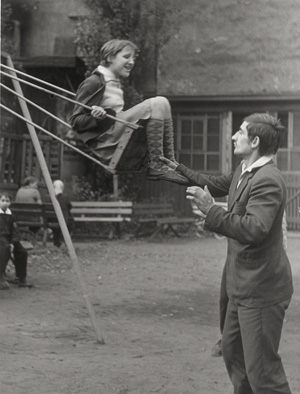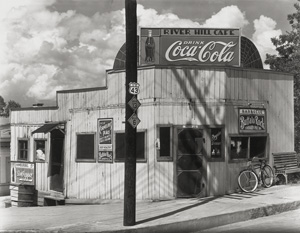Becher, Bernd and Hilla
Schwebebahn-Bahnhof, Werther Brücke, Wuppertal
Los 4091
Ergebnis (inkl. Aufgeld) *
4.000€ (US$ 4,545)
Schwebebahn-Bahnhof, Werther Brücke, Wuppertal. 1972. 3 vintage ferrotyped gelatin silver prints. Various sizes: 21,3 x 30 cm, 18,7 x 30 cm and 13,3 x 30 cm (54,5 x 30 cm). Mounted in a vertical row to board, signed and editioned "17/100" by Bernd Becher in pencil lower right, collector's stamp on mount verso; presented with overmat.
A few small dents/surface scratches, otherwise in very good condition.
Provenance: Carl Vogel Collection
Hochöfen (Blast Furnaces). 1971. Collotype. 44,7 x 31,8 cm. Signed and dated by Bernd and Hilla Becher as well as annotated "Probedruck" in pencil in lower margin.
Creases in corners, soil mark in lower margin, otherwise in good condition. With: Kunst-Zeitung Nr. 2. Bernhard und Hilla Becher. Anonyme Skulpturen. Düsseldorf 1969. - Some traces of use, small tear in lower right corner of front cover, a few light spots.
Bing, Ilse
Rue de la Chaise, Paris (Bec de Gaz)
Los 4094
Ergebnis (inkl. Aufgeld) *
750€ (US$ 852)
Rue de la Chaise, Paris (Bec de Gaz). 1934. Vintage gelatin silver print. 12 x 16,5 cm. Signed and dated by the photographer in white ink in upper left, mounted to original card (minimal traces of use), signed and titled in white ink under image on the mount.
Ilse Bing's move from her birth city Frankfurt to the avant-garde and surrealist scene in Paris marked the start of the most notable period of her career. She produced images in the fields of photojournalism, architectural photography, advertising and fashion, and her work was published in magazines such as Le Monde Illustre, Harper's Bazaar and Vogue. In 1931, Bing's work was exhibited in both France and Germany. Her rapid success as a photographer, and her position as the only professional in Paris to use an advanced Leica camera, earned her the title "Queen of the Leica" coined by the critic and photographer Emmanuel Sougez, whom she met in 1931. – Minimal mirroring in edges, only visible at an angle, otherwise in very good condition. With: 5 folding cards with reproductions of Ilse Bing images (2 double, 1 signed) from the 1930s. Ilkon Press, New York.
Lit.: Larisa Dryansky (ed.). Ilse Bing. Photography through the Looking Glass. New York 2006, ill. p. 137 (variant).
Bismarck Archipelago and Samoa
Views of Samoa, Fiji and Papua including indigenous people
Los 4096
Ergebnis (inkl. Aufgeld) *
875€ (US$ 994)
Photographer: Dr. Arthur Berger (1871-1947) and unknown. Views of Samoa, Fiji and Papua including indigenous people. 1910. Circa 130 vintage collodion paper prints and gelatin silver prints. Each circa 9 x 12 cm or reverse. Inserted in album window mats, bound in canvas album (slight traces of use) with embossed title "Eigene Aufnahmen".
Some photos curled in edges, some faded, some with small tears, otherwise most in good condition.
Provenance: Estate of Dr. Arthur Berger
See also lot 4114 and 4115.
Views of old Danzig. 1920s. 16 vintage toned gelatin silver prints on heavy paper. Each circa 11 x 16 cm and reverse. Each with photographer's blind stamp in lower right corner, mounted to original cream card (minimal traces of use), each with number stamp in upper right corner of mount.
Jan Bulhak was one of the most influential figures in Polish photography during the interwar period, active between 1918-1939. He began photographing around 1905 and worked as an assistant to Hugo Erfurth in Dresden circa 1910-1911, before opening his own studio in Wilno (then Poland) in 1912. From 1919-1939, he lectured at Wilno University, where he also served as head of the Institute of Photography within the Department of Fine Arts. A crucial organizer in the Polish photographic scene, Bulhak co-founded the Wilno Photo-Club in 1927, and the Polish Photo-Club in 1929, where he served as chairman. He was widely exhibited, participating in 174 fine art photography salons both in Poland and abroad. Tragically, most of his negatives were destroyed during World War II, making surviving vintage prints exceptionally rare and seldom seen outside Poland. – Fine tonal prints in near excellent condition.
Robert Frank, Cape Breton. 1998. Vintage gelatin silver print. 29,8 × 39,8 cm. Signed, titled and annotated “Vintage” in pencil as well as photographer’s studio label affixed to the verso.
Some buckling along edges of print, small dent in top left corner, otherwise in very good condition.
Lotte (Auge). 1928. Matte gelatin silver print on Agfa paper, printed 1980. 30,5 x 40 cm (32 x 41,5 cm). Edition stamp, signed by Lotte Burchartz in felt-tip pen and editioned "79/100" on the verso.
Born in 1887, Max Buchartz studied at the Kunstgewerbeschule Elberfeld and the Kunstakademie Düsseldorf. He moved to Weimar in 1921, and in 1926 was appointed professor at the Folkwangschule, where he worked until 1933, teaching graphic design, typography and photography. His 1928 photograph Lotte (Auge), a close-up of his daughter’s eye, was featured in the 1929 Film und Foto exhibition in Stuttgart, and later enlarged as a mural for the 1931 Das Lichtbild exhibition in Essen, becoming an icon of modern photography. – Minimal traces of previous mounting on verso, otherwise in excellent condition.
Lit.: Film und Foto, p. 56, cat. no. 148, ill. p. 44.
Franz Roh/JanTschichold. foto-auge/oeil et photo/photo-eye. Stuttgart 1929, ill. plate 31.
Van Deren Coke. Avant Garde Photography in Germany 1919-1939. Munich 1982, ill. plate 23.
Callahan, Harry
Provincetown Beach, Cape Cod
Los 4103
Ergebnis (inkl. Aufgeld) *
3.500€ (US$ 3,977)
Provincetown Beach, Cape Cod. 1972. Vintage gelatin silver print. 15,3 x 20 cm (20,4 x 25,2 cm). Signed in pencil in lower right margin below the image as well as titled and signed in pencil on the verso.
Harry Callahan’s Cape Cod photographs exemplify his modernist approach to light, space, and form, capturing the vastness of the coastal landscape with a quiet, meditative simplicity. These images, often featuring expansive beaches, delicate horizon lines, and solitary human figures, reflect his lifelong fascination with minimalism and the interplay between nature and human presence. While his earlier work explored abstraction, multiple exposures, and urban geometry, his Cape Cod series embraces a more serene, observational style, emphasizing negative space and tonal subtlety. Prints of this work are in the collections of the Museum of Modern Art (MoMA), the Whitney Museum, the Art Institute of Chicago, The Getty Museum, the Museum of Fine Art Boston, and the National Gallery of Art, Washington. – Corners slightly bumped, otherwise in near excellent condition.
Lit.: John Szarkowski. Harry Callahan. New York, 1977. ill. p. 186.
Harry Callahan. Harry Callahan: Water’s Edge. New York, 1980. ill. plate 1.
Sarah Greenough. Harry Callahan. Boston, 2001. ill. p. 150.
Britt Salvesen and John Szarkowski. Harry Callahan: The Photographer at Work. New Haven, 2006. ill. p. 6.
Ireland. 1979. Dye transfer print. 24,4 x 36,7 cm (44,4 x 56,5 cm). Unsigned.
In the 1980s, Harry Callahan’s foray into color photography marked a significant evolution in his artistic practice. Departing from the stark tonal contrasts of his earlier black-and-white work, Callahan embraced vibrant hues and complex compositions. He frequently captured urban scenes, nature, and architectural details, utilizing techniques like multiple exposures and reflections in glass surfaces to create striking visual effects. This period demonstrated his deep engagement with the possibilities of color, displaying his continued exploration of form, light, and abstraction. Notably, prints of this work are held in the collections of the Minneapolis Institute of Art and the Nelson-Atkins Museum of Art.Prints of this work are in the collections of the International Centre of Photography and the Nelson Atkins Museum. – Some light handling creases, otherwise in excellent condition.
Atlanta. 1984. Dye transfer print. 24,4 x 36,7 cm (45,7 x 56 cm). Signed "Callahan" in pencil on the verso.
Another print of this work is in the collection of the Museum of Modern Art (MoMA), New York. – Some small creases in margins, otherwise in near excellent condition.
Henri Matisse. 1965. Gelatin silver print, printed later. 35,3 x 24 cm (circa 45 x 33 cm). Signed and dedicated by the photographer in ink as well as photographer's blind stamp in lower margin. Framed under glass in wooden frame.
Henri Cartier-Bresson is perhaps best known for his candid street photography and his founding role in the Magnum agency. However, his portrait work is also significant, showing his ability to capture the essence of his subjects with both intimacy and depth. In his portrait work, Cartier-Bresson had the rare gift of letting his sitters forget the camera's presence, resulting in candid photographs, characterized by their simplicity and honesty. – In excellent condition.
Pablo Neruda. Circa 1965. Gelatin silver print, printed later. 35,3 x 24 cm (circa 45 x 33 cm). Signed and dedicated by the photographer in ink as well as photographer's blind stamp in lower margin. Framed under glass in wooden frame.
In excellent condition.
Charpie, Jean
Still life with eggs and egg slicer
Los 4109
Ergebnis (inkl. Aufgeld) *
1.000€ (US$ 1,136)
Still life with eggs and egg slicer. 1945-48. Vintage ferrotyped gelatin silver print. 28,5 x 23 cm. Mounted to original board (slightly time-stained), signed by the photographer in pencil below image on mount; printed label on mount verso.
Jean Charpie, a professor at the Schule für Photographie in Vevey, Switzerland, was the author of popular book Traite de Photographie. – Slight irregularity to ferrotype surface, otherwise a fine tonal print in near excellent condition.
Curtis, Edward Sheriff
The Vanishing Race, Navaho
Los 4113
Ergebnis (inkl. Aufgeld) *
2.750€ (US$ 3,125)
The Vanishing Race, Navaho. 1904. Platinum palladium print. 29,5 x 40 cm (45,8 x 55,4 cm). Signed by the photographer in lower right, with the photographer's copyright stamp embossed in lower left corner. Sandwich-mounted to original mat (some light abrasion marks).
Edward Sheriff Curtis was a pioneering American photographer and ethnologist, celebrated for his comprehensive documentation of the Indigenous peoples of North America. His magnum opus, "The North American Indian," stands as a monumental photographic and ethnographic study, capturing the culture and traditions of over 80 Native American tribes during the early 20th century. Curtis dedicated decades of his life to this ambitious project, traveling extensively across the United States to document the daily lives, ceremonies, and customs of Indigenous communities. Through his evocative photographs and detailed ethnographic notes, Curtis sought to preserve and honor the rich cultural heritage of Native American tribes, providing future generations with invaluable insights into their way of life. – A few surface irregularities, otherwise in excellent condition.
Lit.: Edward S. Curtis. The North American Indian. Vol. 1: The Apache. The Jicarillas. The Navaho. Cambridge 1907, ill. plate 1.
Christopher Cardozo. Native Nations. First Americans as seen by Edward S. Curtis. Boston 1993, ill. p. 122.
Christopher Cardozo. Edward S. Curtis: The Great Warriors. New York 2004, ill. p. 7.
Deutsch- and British Ostafrika
Views of Africa, Egypt and India
Los 4114
Ergebnis (inkl. Aufgeld) *
688€ (US$ 781)
Photographer: Dr. Arthur Berger (1871-1947) and uniknown. Views of Africa, Egypt and India. 1908-09. Several hundred vintage collodion paper prints. Each circa 9 x 12 cm or reverse. Most with archive stamp "Photo-Centrale des Kolonialkriegerdank" and annotated in ink on the verso.
Dr. Arthur Berger was a physician and hunter active in German East Africa during the early 20th century, known for his widely read travel books. In addition to his writing, he produced numerous photographs documenting the landscapes and communities he encountered, offering a vital visual record shaped by the context of the colonial era.
– Some photos curled in edges, some with small tears, otherwise most in good to very good condition.
Provenance: Estate of Dr. Arthur Berger
See also lot 4096.
Lit.: Dr. A. Berger. Der heilige Nil. Berlin 1924, ill. p.15, 49, 65, 81 and 113.
Dr. A. Berger. Der heilige Nil. Berlin 1935, ill. p. 32, 49, 80, 97 and 112.
Deutsch Ostafrika and Kenya
Views of Deutsch Ostafrika and Kenya
Los 4115
Ergebnis (inkl. Aufgeld) *
1.250€ (US$ 1,420)
Photographer: Dr. Arthur Berger (1871-1947) and unknown. Views of Africa, Egypt and India. 1908-09. Circa 500 vintage collodion paper prints. Each circa 9 x 12 cm or reverse. Most with archive stamp "Photo-Centrale des Kolonialkriegerdank" and annotated in ink on the verso, inserted in album window mats, bound in 3 canvas albums (slight traces of use) with embossed titles.
The present albums document various travel locations in East Africa, featuring striking images of indigenous communities - including the Kikuyu, Maasai, and others - alongside hunting scenes, landscapes, village life, and glimpses of European colonial presence, particularly in Dar es Salaam. – Some photos curled in edges, some with small tears, otherwise most in good to very good condition.
Provenance: Estate of Dr. Arthur Berger
See also lot 4096.
Lit.: Dr. A. Berger. Der heilige Nil. Berlin 1924, some illustrated.
Dr. A. Berger. Der heilige Nil. Berlin 1935, some illustrated.
Vandalism (74V01). 1974. Vintage gelatin silver print. 17,8 x 17,8 cm (35,2 x 27,7 cm). Signed and dated in pencil on the verso.
John Divola’s "Vandalism" series (1974/75) comprises black-and-white photographs of abandoned houses in Southern California, where the artist enacted spontaneous interventions by spray-painting bold marks, lines, and shapes onto the interiors. These performative gestures blur the boundaries between photography, painting, and conceptual art, foregrounding themes of entropy, transgression, and authorship. Visually arresting and charged with tension, the images capture a dynamic interplay between deterioration and artistic intent, transforming sites of neglect into ephemeral canvases. – Some traces of glue from previous mounting on top margin, small tears in left margin, otherwise in near-excellent condition.
Lit.: John Divola. Vandalism. London 2018.
Abstract trees. 1975. Gelatin silver print, printed 1979. 39,8 x 30 cm. Photographer's stamp and annotated by the photographer in ink on the verso.
Slightly buckled in edges, otherwise in very good condition.
Dziworski, Bogdan
Street scenes of children in Lodz
Los 4118
Ergebnis (inkl. Aufgeld) *
438€ (US$ 497)
Street scenes of children in Lodz. Late 1960s. 2 vintage, large-format ferrotyped gelatin silver prints. 41 x 52,5 cm and 49 x 40,3 cm. Each with photographer's stamp on the verso.
Bogdan Dziworski studied cinematography at the Lodz Film Academy. As a cameraman, director and documentary filmmaker, he has made numerous films and was Dean of the Film Academy in Katowice. He has published many illustrated books and participated in various exhibition projects. His photographs show a quirky contrast between the run-down environment and the carefree nature of the people who live in it. His particular eye for children and older people is evident, and many of his images have a filmic quality. – Some irregularities to ferrotype surface, a few crease marks, corners slightly bumped, slight edge wear, otherwise in good condition.
Children in Lodz. Late 1960s. 4 vintage ferrotyped gelatin silver prints. Each circa 24 x 18 cm. Each with photographer's stamp and layout marks in pencil on the verso.
Some light pitting to ferrotype surface, a few light handling marks, a few corners bumped, otherwise in good condition.
Lit.: Bogdan Dziworski. My View. Polish Impressions in Photography. Vienna 1981, two ill., unpaginated.
River Hill Café, Alabama. 1936. Gelatin silver print, printed later. 29,2 x 36,8 cm. Titled and dated as well as annotated by another hand in pencil on the verso; "Walker Evans - Gelatin silver print from the original negative" stamp on the verso.
Corners slightly bumped, crease in top right corner, otherwise in very good condition.
[*]: Regelbesteuert gemäß Auktionsbedingungen. [^]: Ausgleich von Einfuhr-Umsatzsteuer.
* Alle Angaben inkl. 25% Regelaufgeld ohne MwSt. und ohne Gewähr – Irrtum vorbehalten.
Galerie Bassenge
Erdener Str. 5A
14193 Berlin
Öffnungszeiten:
Montag bis Donnerstag, 10–18 Uhr,
Freitag, 10–16 Uhr
Telefon: +49 30 8938029-0
Fax: +49 30 8918025
E-Mail: info (at) bassenge.com
Impressum
Datenschutzerklärung
© 2024 Galerie Gerda Bassenge
Galerie Bassenge
Erdener Str. 5A
14193 Berlin
Öffnungszeiten:
Montag bis Donnerstag, 10–18 Uhr,
Freitag, 10–16 Uhr
Telefon: +49 30 8938029-0
Fax: +49 30 8918025
E-Mail: info (at) bassenge.com
Impressum
Datenschutzerklärung
© 2022 Galerie Gerda Bassenge

